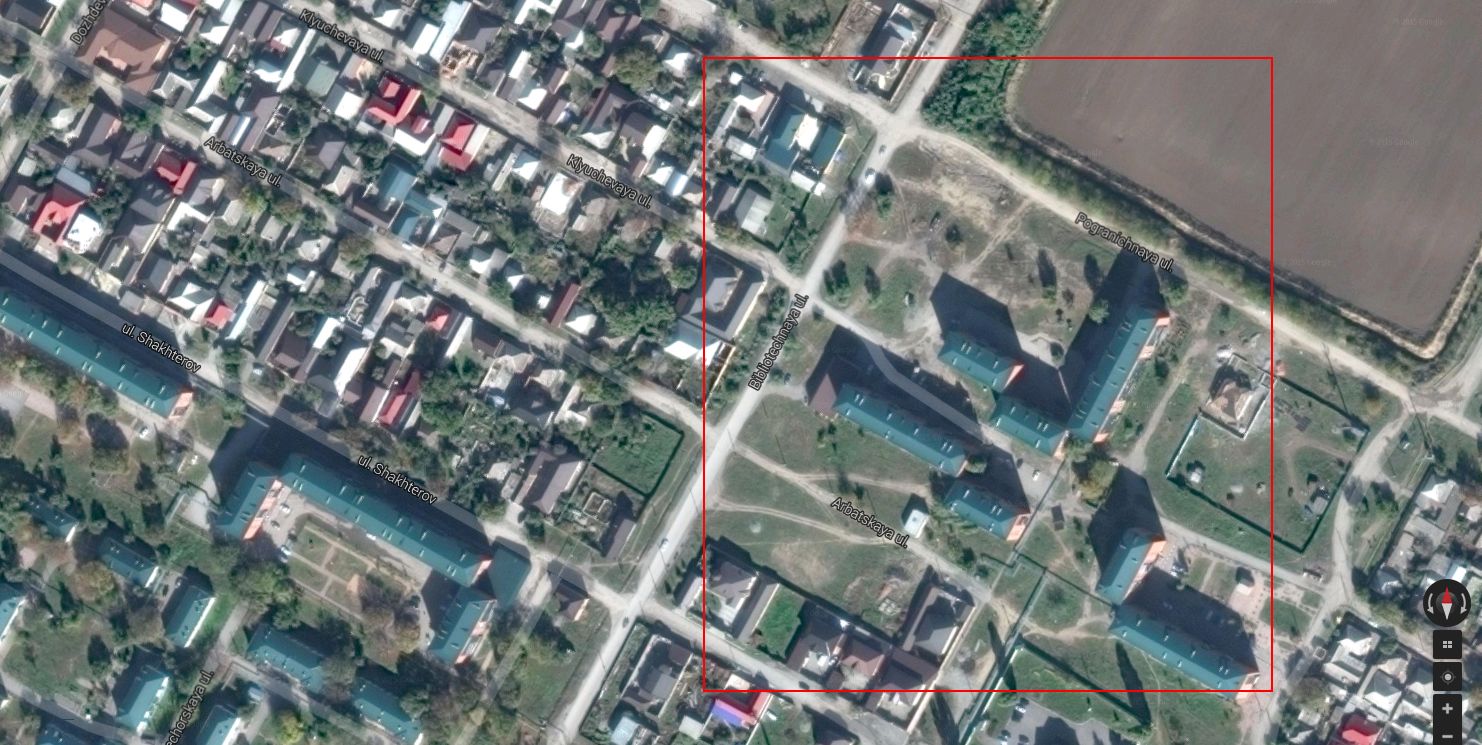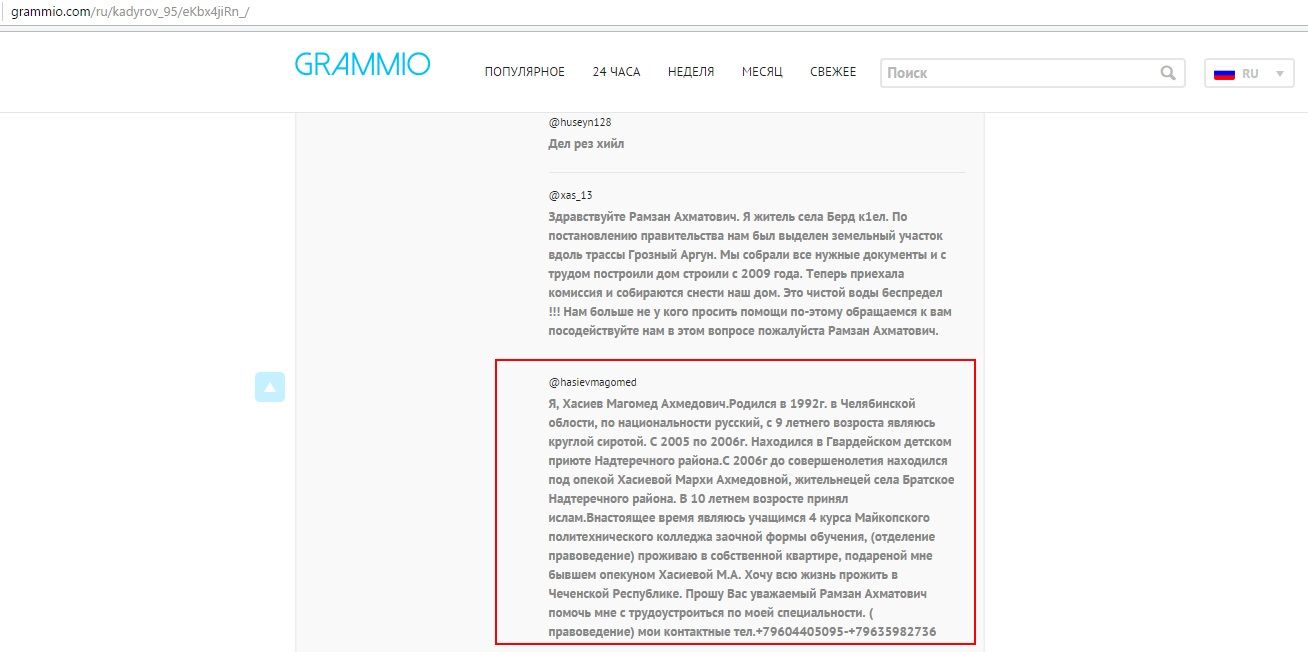The previous post in our Putin in Syria column can be found here.
The Syrian Local Coordination Committees (LCC) report heavy casualties following Russian strikes on roads north of Aleppo.
According to the LCC, at least 25 people were killed when Russian jets bombed the village of Karfarnaseh, around 20 kilometres outside Aleppo.

Another LCC report, published around half-an-hour ago, claims that Russian jets targeted vehicles on the same road, between Azaz and Ihris, causing several fatalities.
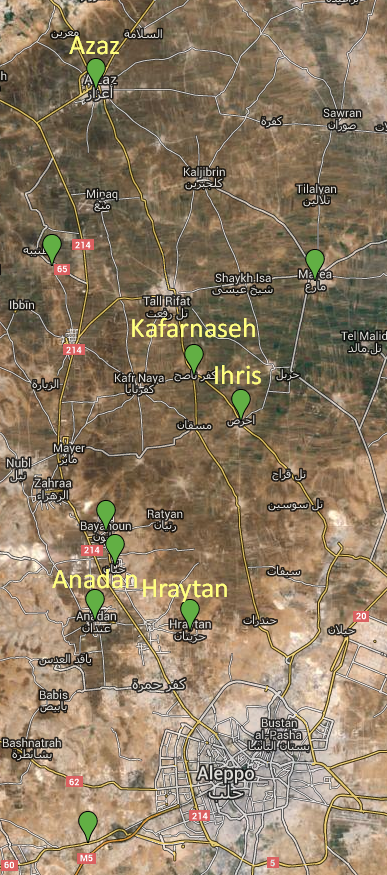
Azaz itself and the border crossing with Turkey has been struck repeatedly since Turkish jets downed a Russian bomber on November 24.
Today, the Russian Ministry of Defence presented claims that the crossing was being used to ferry oil from ISIS-controlled territory into Turkey in order to justify these attacks.
The LCC reported that two children were killed in the strikes near Anadan and nearby Hraytan.
Looking at satellite imagery, we can confirm that the target struck is indeed a site around six kilometres southeast of Khafsa Kabir, southeast of Aleppo and west of al Raqqa. This area is controlled by ISIS.
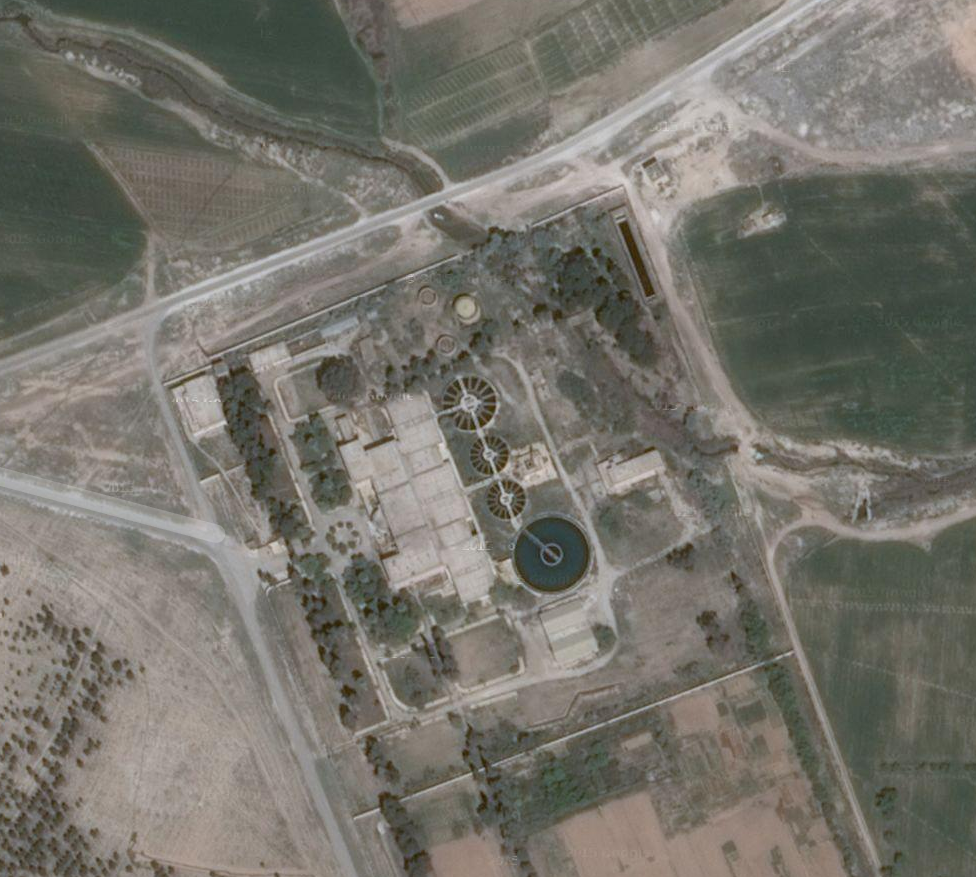
However the site does not resemble an oil refinery. Instead the tanks appear, to this author’s untrained eyes, and those of several other observers, to be part of a water treatment system.
Note that the site is located on the shores of Lake Assad and compare the tanks with those at a larger site, labelled no later than two years ago as a water treatment plant on Wikimapia:
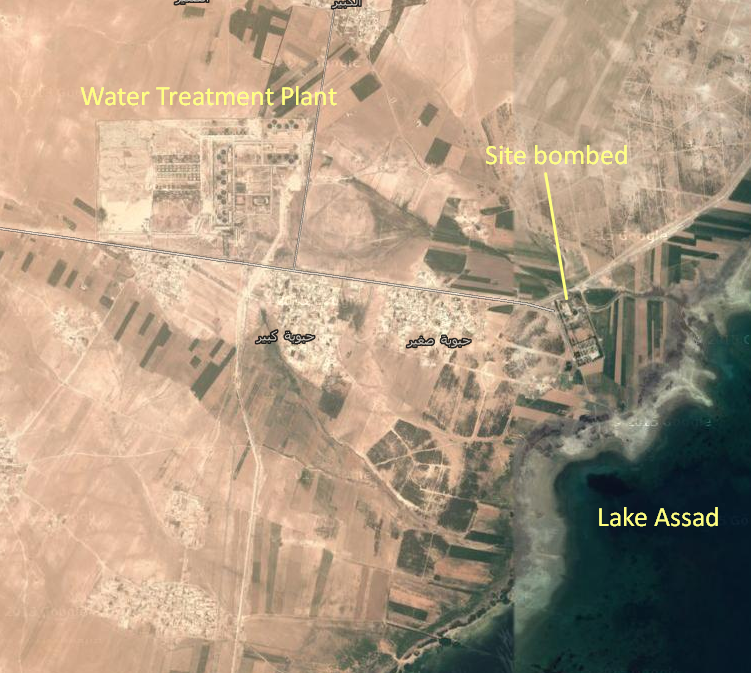
A closer view of the water treatment plant:
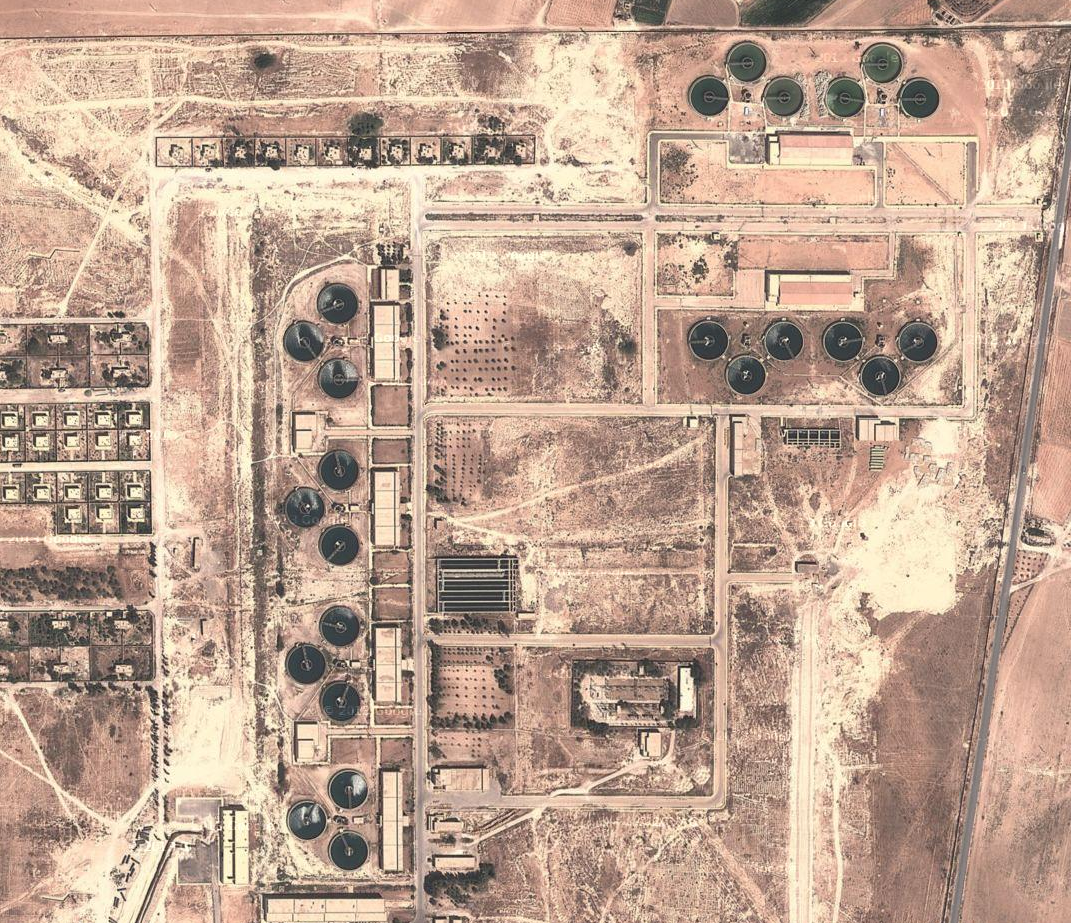
A comparison of the structures at both the larger site and the target struck by Russian bombs:
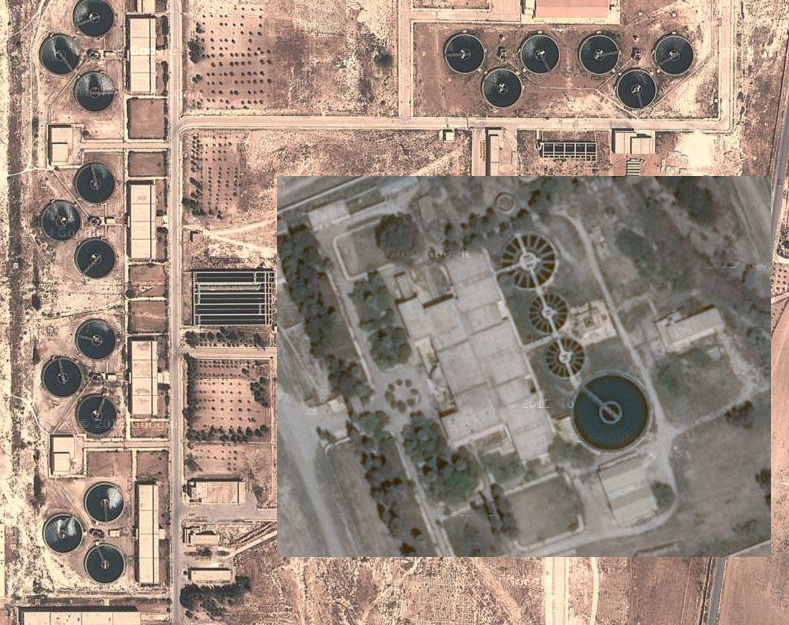
Note the completely-analogous structure at both facilities.
Furthermore, if we use Wikimapia, an open-source platform, to examine other known Syrian oil refineries, there are significant differences. Take this very large facility in Homs (map):
We can see similar structures in Baniyas and even a small refinery in Al Raqqah — while these facilities look very different to us than the one released by the Russian government, the video is a near-perfect comparison to other known water treatment plants.
And it’s not just this facility where the Russian narrative appears to break down. The MOD published another video of a strike on a purported oil refinery in the same area.
Once again this site bears little resemblance to an oil refinery. Microblogger and analyst @markito0171 identifies the site as a grain silo:
Christiaan Triebert, a graduate student of war studies and intern at the International Centre for Security Analysis, geolocated the site near Tuwayzan, which lies a considerable distance further along the banks of Lake Assad, 50 kilometres from Khafsa Kabir.
Furthermore, we can compare the site with satellite imagery of other grain silos from Wikimapia:
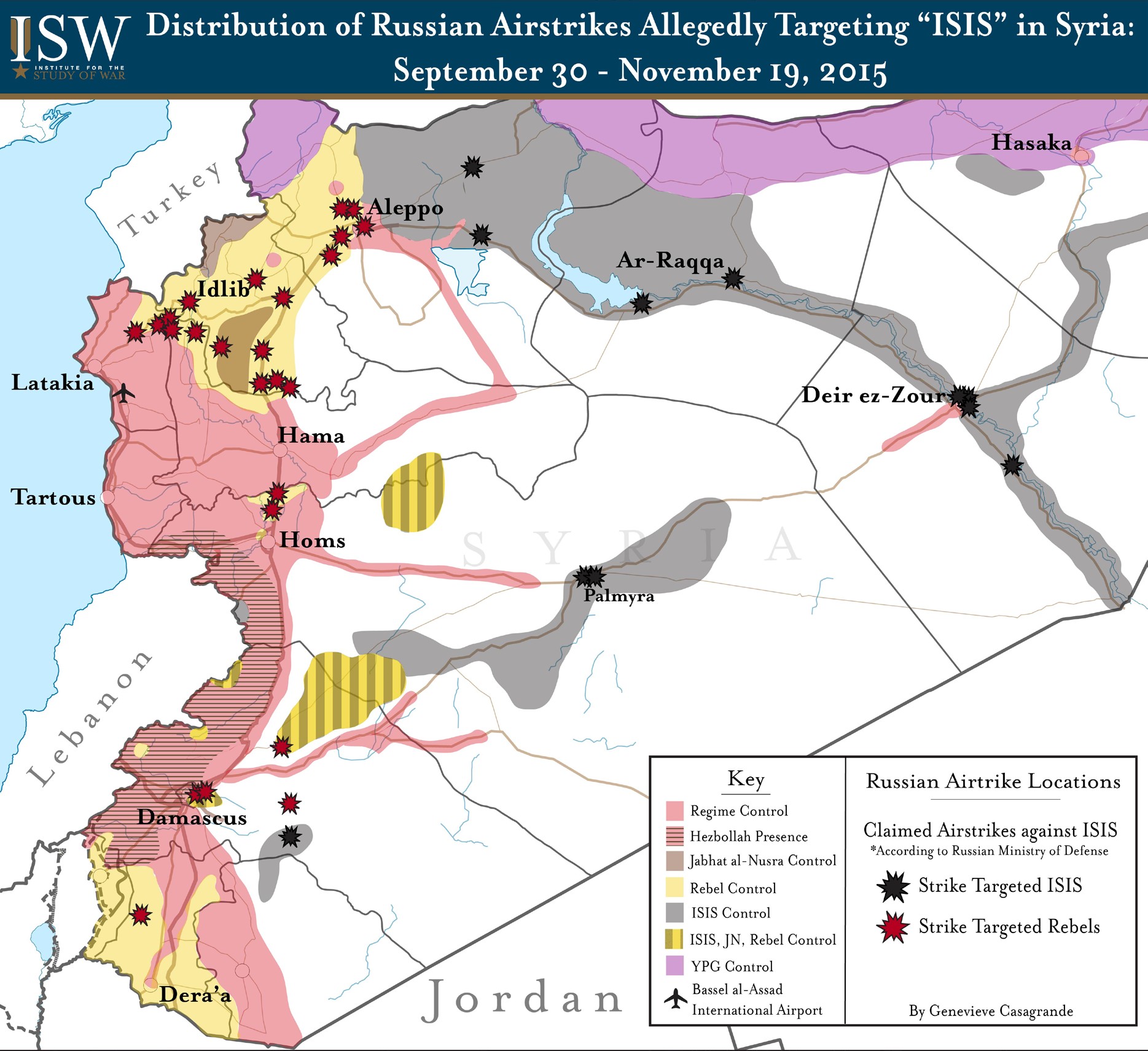
5 Myths: Russia's False ISIS Narrative In Syria
Hugo Spaulding – President Vladimir Putin is actively misinforming his domestic audience and the international community about Russia's first military intervention outside the former Soviet Union since Afghanistan. Putin has created a false narrative about the Islamic State of Iraq and alSham (ISIS) to disguise the true objectives behind Russia's intervention Syria and is using this narrative to manipulate the international community.
The executioner speaks fluent Russian in a non-Muscovite accent. The victim speaks fluent Russian with a slight Caucasian accent and uses some terms common to people from that region (such as makary for “villages”).
The Chechen man identifies himself as Magomed Akhmetovich Khasiyev, born August 4, 1992 in the Chechen Republic, a Russian citizen, who went by the name of “Kharun” while fighting with ISIS.
A picture of another man with a shaven head is superimposed over Khasiyev’s face several times — this might be a picture of him before he grew a beard.
In the full video, at 3:13, the camera pans down to the hands of Khasiyev as he is reciting his confession, to show he is in handcuffs.
While the video purports to show Khasiyev’s execution by showing the cutting of his neck and his lifeless head, the execution and his identity have not been confirmed.
The following is a full translation of the statements in the video from Russian by The Interpreter:
I am Khasiyev, Magomed Akhmetovich [born] 04/08/1992 [August 4, 1992], ethnic Russian, from the Chechen Republic. Here at the Caliphate, I am called “Kharun.”
I came to the Caliphate on assignment from the Federal Security Service (FSB) of Russia. Before I came to the Caliphate, I lived in the Chechen city of Grozny, on Bibliotechnaya Street, 112, apt. 30 in the Staropromyslovsky District.
I would like to confess the purpose with which I came to the Caliphate. Who, when and for what reason I was sent here. So. In early 2014, I lived, worked and studied in the city of Maykop. I had my own apartment there, really, everything was great.
In mid-2014, I came to the city of Grozny from the city of Maykop. Upon departure from Maykop, our commuter bus was stopped, and officers came on the bus under pretext of checking ID. I and several other young people were taken off the bus and taken in various directions. I was immediately brought to the Russian FSB’s [local] office in the city of Maykop.
An older man in civilian clothing approached me. He introduced himself as an agent and major in the FSB who said his name was “Shamil.” Our conversation started out with them saying they know that I gotten high with Lyric pills [the pain-reliever pregabalin—The Interpreter] and they asked where, at which pharmacy I got them. Then our conversation smoothly turned to the topic of Syria and the Islamic State. He asked if I had a connection to a Chechen [named] Kharan, and his brother, Abdulla. Here I understood why I had been brought there, and that it was useless to object, as in fact they had a print-out of all my contacts.
So naturally I told them how many times I had been in touch with Kharan and when I was in contact with Kharan. After I told them everything, they released me. I spent eight days there in total. During those eight days I met with Shamil three times. During those meetings, it was offered to me to go to Islamic State territory and work for the Russian FSB. I agreed, and signed all the documents which I was given over Shamil’s signature. As I understood it, this was my contract for cooperation with the FSB.
During these same meetings, Shamil gave me full instruction as to how we would operate, when we would operate, and how there would be communication between us. In general, I did not contact Shamil directly, so the brothers would not suspect. We had a messenger between us named Grant. Grant was my old friend, an ethnic Armenian. He also turned out to be a good acquaintance of that Shamil. I was supposed to get in touch with Grant once a month. I was assigned to find out the full identity of the brothers who meet together in the Caucasus and also establish the identity of those who were in the Caliphate from the city of Maykop and the city of Grozny. It was also stressed that I learn precisely about where and when the mujahideen intended to set off explosions in the Russian Federation.
In general, my assignment was to find out and pass through Grant the maximum amount of information — first names, last names, photos, villages. Thus, fully instructed, after 8 days, I went to Grozny. There I was able to get a foreign passport in 2-3 days. After 2-3 days I left [Russia] via Krasnodar Airport for the city of Istanbul.
In Turkey, I was met by a person who is involved in sending people from Turkey into the Islamic State. There, after spending several days in his apartment, somewhere about August 26, 2014, I arrived in the Islamic State. In the company of [?] I was sent to Iraq. There in Iraq, I continued to collect information.
When I got back from Iraq, I transmitted the information about the two brothers, Kharan and Abdulla. At that time those brothers had became shakhidy [suicide bombers--The Interpreter]. Two months later, I transmitted… I got in touch with the FSB and gave information about a brother from [the Russian republic of] Karachayev [Karachayev-Cherkessia–The Interpreter]. When I sent his information, the FSB agents couldn’t immediately establish his exact information; when a person crosses into the Caliphate, their names are changed and they take other Muslim names. And when they are referred to by the Muslim names here, the FSB agents find it hard to establish their exact personal data.
So on the whole, in all that time, I managed to get in touch… I got in touch with the FSB five times and sent them information about 6 brothers. And the last time I got in touch with the FSB, I sent information about a brother who studied at [beep, evidently to censor out location–The Interpreter] Med…Medical Institute. And with that I had my last contact. Shamil told me to await further instructions. But I was unable to await further instructions or pass on further information because I was caught, and totally exposed by officers of the security service of the Caliphate.
At that point the text appears:
You were humiliated, oh Russians…
Then the film cuts to an outdoor shot, with the executioner making a stilted statement as follows:
Listen to me, dog Putin. Let your stooges listen to me. Before your arrival, the Assad regime bombed us, after which America bombed us with its cowardly coalition, after which you bombed. And this brought us nothing except for stoicism and conviction that we are in the truth. All unbeliever peoples are against those who are in the truth. And your airstrikes didn’t bring anything except the death of civilian Muslims — children, women and old men.
And we expected your joining of those tyrants, knowing of your bloody history in Afghanistan, in Chechnya and in the Caucasus. Oh, unbelievers of Russia! We long awaited a meeting with you, looked for a way to you, but by the grace of Allah, you yourself came here. And now here, on this blessed earth, the battle will begin: blood for blood, destruction for destruction. Oh, people of Russia!
You are being dragged into a war you know you will lose. Oh, people of Russia, you will not be safe. We will kill your children for every child killed here. And we will destroy your homes for every destroyed home here. Oh, mothers of Russia! Keep your sons back, otherwise they will meet this fate.
At this point, the executioner appears to slash the throat of Khasiyev and the song picks up again:
Soon, very soon, blood will flow like the ocean. The infidels’ throats will quiver from knives.
Several points about Khasiyev’s statement:
The address he gives of 112 Bibliotechnaya St. does exist in Grozny on Google maps and there is a large apartment complex at that address on the edge of Grozny.
Russian bloggers have gotten to work trying to find the existence of a Chechen man with this name on social media.
A Twitter user who describes himself as an administrator of a Russian-language 2chan site said he had found a post by Khasiyev on the Instagram of Chechen President Ramzan Kadyrkov.
Translation: It seems he wrote on Kadyrov’s Instagram earlier…Maykop coincides.
We were able to locate a Russian-language site that happens to have the post Kadyrov made on September 12, 2013, and the comments on his post, including one from @hasievmagomed. (It is common for readers to address appeals to the president on his Instagram page.)
The translation of the screenshot of the Instagram post made by the account with the name @hasievmagomed is as follows:
I, Magomed Akhmedovich Khasiyev, born in 1992 in Chelyabinsk Region, Russian by ethnicity [nationality], since the age of 9 have been a total orphan. From 2005-2006. I was at the Guards Orphanage in Nadterechny District. From 2006 until I reached adulthood, I was under the care of Markha Akhmedovna Khasiyeva, a resident of the village of Bratskoye in Nadterechny District. At the age of 10, I accepted Islam.
At the present time I am a remote learning student in the 4th year of Maykop Polytechnical College (in the justice department), I live in my own apartment given to me by my former foster parent M.A. Khasiyeva. I want to spend my whole life in the Chechen Republic. I ask you respected Ramzan Akhmatovich to help me to get a job in my profession (justice). My contact telephones:
The name, patronymic and last name match as do the year of birth, but in the video account, Khasiyev doesn’t mention that he was born in Chelyabinsk Region; he said he lived in Grozny before moving to Maykop.
The screen name “hasievmagomed” on Instagram is for the account @Magomed_92 which would match his stated date of birth, but the account currently is blank without pictures or posts.
Thus neither the video or the purported execution have any external confirmation.
Although he often posts remarks condemning ISIS and blaming the West for its existence, Kadyrov has not commented at all in the last day about this alleged execution of this Chechen supposedly recruited by the FSB to inform on other Chechens. Kadyrov has posted numerous comments this week about visiting mosques, watching his sons perform sports, and working out himself. He is currently in Moscow for President Vladimir Putin’s annual address, and met with Putin aide Vyacheslav Volodin today.
— Catherine A. Fitzpatrick, Pierre Vaux
Turkey has stepped up its counter-terrorism efforts after ISIS was blamed for both the July 20 Suruc bombing and two Ankara suicide blasts, including the October 10 train station bomb, the deadliest in Ankara’s history leaving more than 100 dead and hundreds injured.
— Catherine A. Fitzpatrick
The Russian Ministry of Defence held a press conference this afternoon at which they presented their claims that Turkey is buying oil from ISIS.
The move follows comments from the prime minister, Dmitry Medvedev, in the aftermath of the downing of a Russian Sukhoi Su-24 bomber on November 24, that “certain Turkish officials have direct financial interest in deliveries of oil products from ISIS-owned facilities.”
At today’s press conference Sergei Rudskoy, head of the General Staff’s operative command, told the audience that three main oil routes from ISIS-controlled territory in Syria had been identified.
According to Rudskoy, one route takes oil out west via Aleppo and the border town of Azaz to the Turkish ports of Dortyol and Iskenderun.
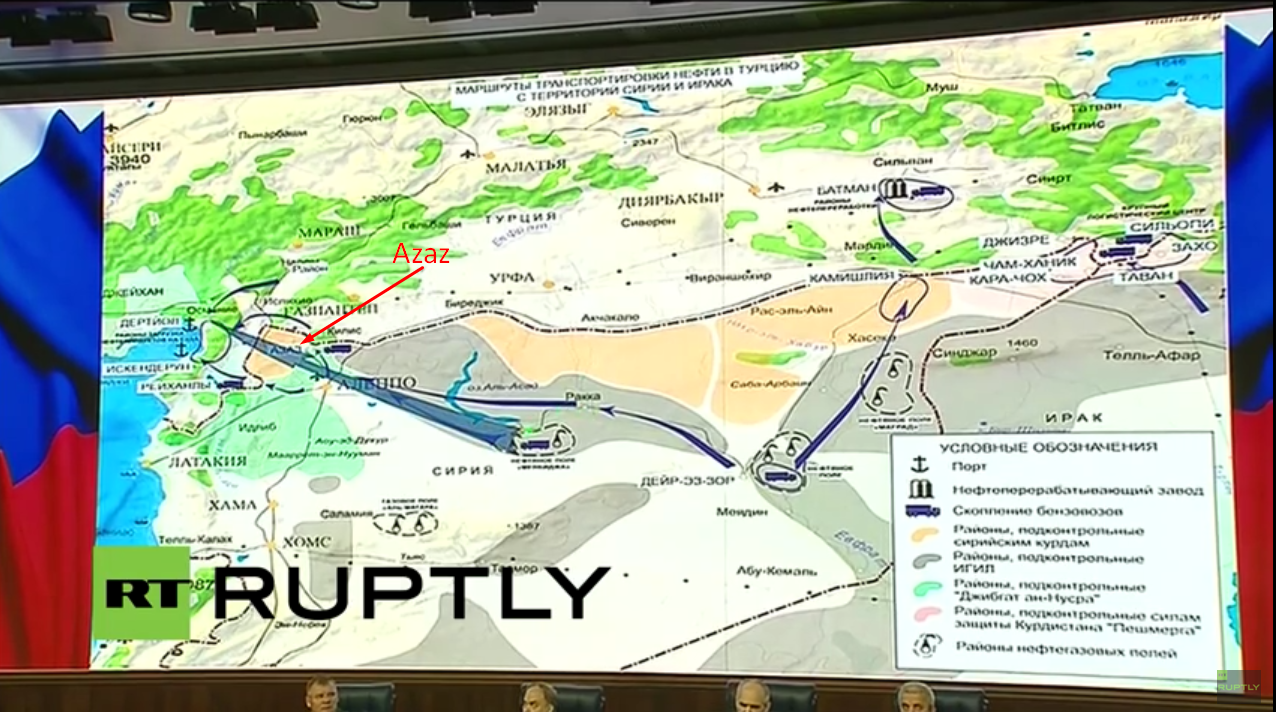
Rudskoy produced reconnaissance photos which, he said, showed 240 oil tanker trucks and articulated lorries parked on the Turkish side of the border near Azaz, with 46 on the Syrian side “waiting to cross the border.”
Footage purportedly showed oil tankers waiting in what Rudskoy claimed was Jabhat al-Nusra-controlled territory near Bab al-Hawa, west of Aleppo.
Russian satellites, he said, had tracked the tankers to Dortyol and Iskenderun, where one tanker was unloaded every day.
Both Bab al-Hawa and Azaz have been subjected to repeated air strikes since November 24, inflicting heavy casualties and, the Turkish IHH aid organisation (which is closely associated with President Recep Tayyip Erdogan) claimed, destroying trucks carrying humanitarian relief.
A second route described by Rudskoy runs north from the oil fields of Deir ez-Zor to a Turkish refinery in Batman.
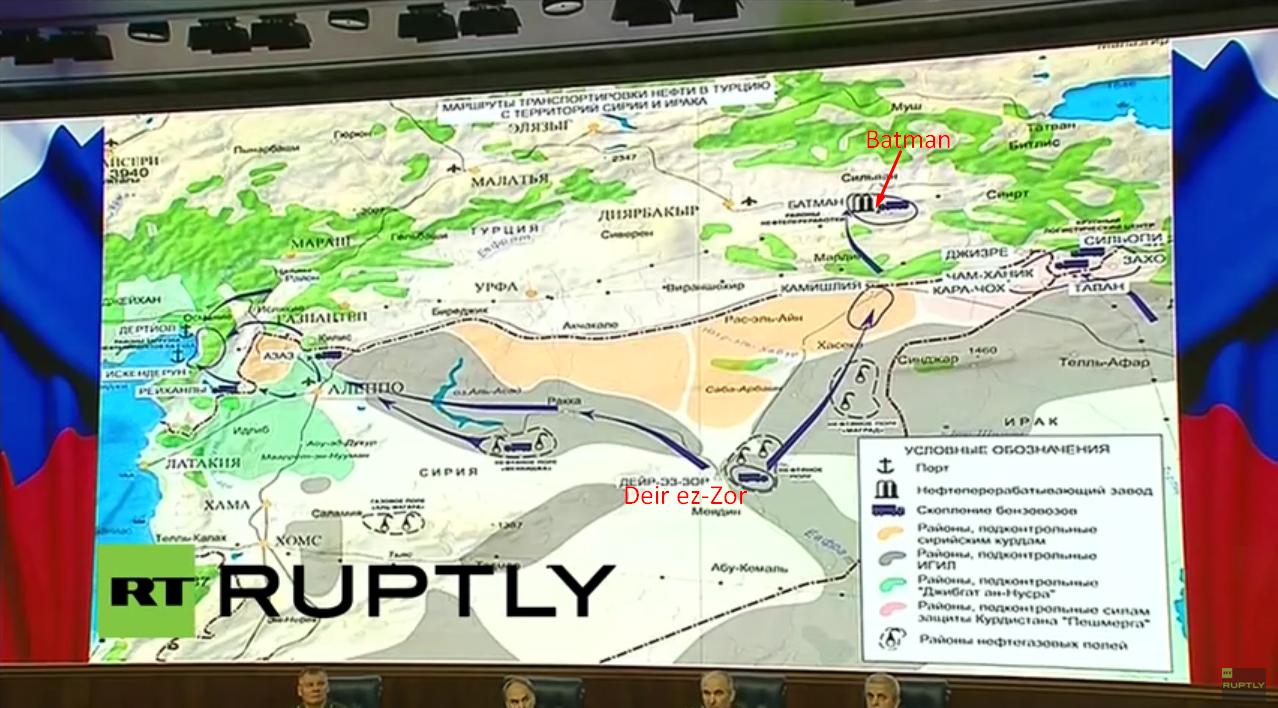
Finally, Rudskoy identifies a third route, from oil fields in northeastern Syria and northwestern Iraq, near the Turkish town of Silopi.
Interestingly, this would mean that ISIS is running oil through territory controlled by Kurdish YPG and Iraqi Peshmerga forces, as indicated in the latest maps from the Institute for the Study of War.
Claims that Turkish officials may be involved in the oil trade with ISIS are nothing new in themselves.
The Guardian‘s Martin Chulov wrote on November 24:
Despite that, links to some aspects of Isis continued to develop. Turkish businessmen struck lucrative deals with Isis oil smugglers, adding at least $10m (£6.6m) per week to the terror group’s coffers, and replacing the Syrian regime as its main client. Over the past two years several senior Isis members have told the Guardian that Turkey preferred to stay out of their way and rarely tackled them directly.
Concerns continued to grow in intelligence circles that the links eclipsed the mantra that “my enemy’s enemy is my friend” and could no longer be explained away as an alliance of convenience. Those fears grew in May this year after a US special forces raid in eastern Syria, which killed the Isis official responsible for the oil trade, Abu Sayyaf.
A trawl through Sayyaf’s compound uncovered hard drives that detailed connections between senior Isis figures and some Turkish officials. Missives were sent to Washington and London warning that the discovery had “urgent policy implications”.
What Russia is adding today is an attempt to justify their strikes on Azaz and Bab al-Hawa.
Another issue is that much of the reconnaissance data presented today dates back to August. Why then has Russia waited until now to make these claims if not just as revenge for the downing of the Sukhoi?
At the press conference, Mikhail Mizintsev, head of the National Defence Administration Centre, went on to claim that the profits from selling ISIS oil went to “the top military and political leadership of Turkey,” and were being used to pay for weapons and ammunition and mercenaries supplied to ISIS, Jabhat al-Nusra and other groups.
“According to our trusted reconnaissance data, Turkey has carried these activities for a long time, it’s been done on a regular basis, and we believe that Turkey does not plan to stop these activities. According to the information we have on hand, on the size of the supplies by Turkey – weapons, ammunition, explosives components, communications means and other materiel, and also, the training of militants in training camps on Turkish territory. This information will be presented next week.”
— Pierre Vaux


